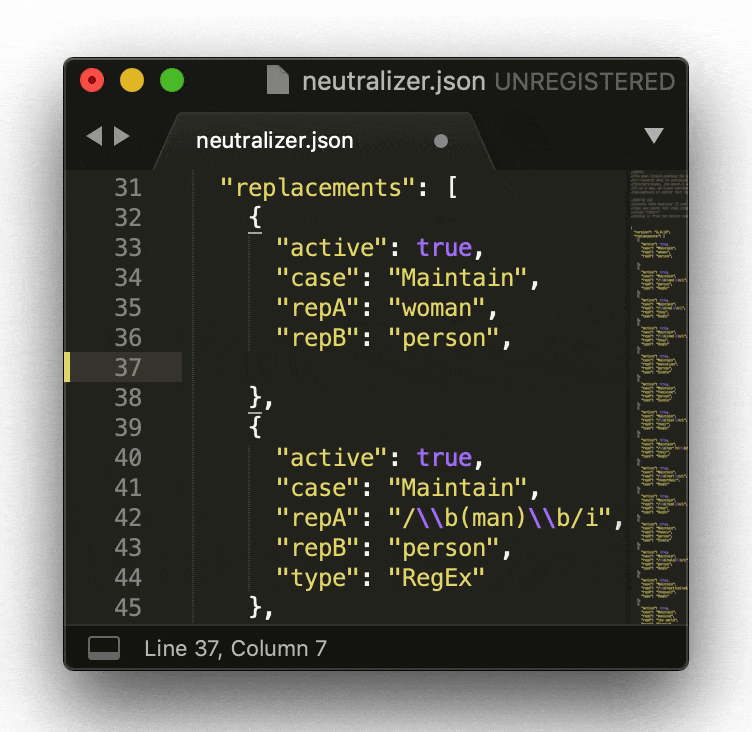NEUTRALIZER.JSON
NEUTRALIZER.JSON
Prototyping a gender-neutral internet.
“Robot love is queer!”
- Janelle Monae ‘Our Favorite Fugitive (Interlude)‘
During research this past semester a few questions kept floating around in my head:
How would I interact with the internet without gendered pronouns?
How would news articles read?
What assumptions would I make about subjects of hxstorical documents and encyclopedic entries?
Is there a way to automatically neutralize text online?
So I quickly googled for a Chrome extension and only found a plugin called Gender Neutralizer that had a lot of cool ideas in it, but unfortunately didn’t work since it’s been deprecated and just never got completed (it’s still worth checking out, the theoretical options on it are thought-provoking). So instead I went for basic and looked for simply an extension that could find and replace words, and I found Word Replacer II. So I spent a while figuring out the syntax for replacements and set up a functional but clunky prototype. But luckily after some way deeper digging I stumbled onto an older start to this same use case in Word Replacer by a lovely Dutch person named Weston Renaud. I combined that script with my own, set up another Gist project, and began further testing & editing. The end result is neutralizer.json, which runs inside of the Word Replacer extension.
From what I’ve been able to find, it’s the fastest way to quickly preview an internet with completely neutralized pronouns. It’s a solid start, but it’s not anywhere near perfect (the grammar gets butchered plenty), and it needs far more development. So please, please, please if you’re reading this and have strong computer science skills, reach out and get on the Gist page!
What’s the point of this?
Which is a question I’ve gotten plenty of times.I’m curious to neutralize everyone because:
It might reduce daily dysphoria.
I wish my universe was pronoun-neutral and would like to simulate this queer world-building digitally.
It could illuminate subtle identifiers & phrases not commonly expected to gender people.
Why not try it?
Problems
Problematic English Words & Phrases to figure out:
Is->are when not directly following pronoun
Sir (as a title)
Miss and Misses (as nouns)
"he who goes about his business”
“thus appointed female roommate”
“They has”
her sometimes = them/their, while him always = them. ex:
“her surveillance” -> their surveillance colleague
“belongs to her” -> belongs to them
“belongs to him” -> belongs to them
“his surveillance” -> their surveillance
There’s plenty of issues with this neutralizer though, in both social and technical contexts. To name some of the former: non-consensual pronoun assignment (I can imagine cases in which people would like their binary gender affirmed), reducing visibility of womxn, and possibly causing dysphoria for some people. Not to mention the other huge problem—this only supports the English language right now! We need to figure out working translations and conjugations for as many languages as possible (or at least as many that actually have syntax neutralizers floating around).
I like the collaborative spirit that Git/Gist makes possible for this, although it could certainly be a friendlier language or even a non-coding scratch-esque system so more people could get involved. Currently working with this is a inaccessible to most without some basic computer science experience.
On a more specific technical level we can deal with right now, there’s lots of problematic English phrases and words that we haven’t found a way to fix using the simple code system set up so far.
How to Install (approx. 2 minutes)
In the Chrome browser, go to the Word Replacer II page and install the extension by following their instructions.
This how to but in GIF form.
Next, pop open another tab/window and go to the neutralizer.json Gist page to copy the script text in this window starting from the first open bracket below the intro comments all the way to the end bracket of the file
Now click on the Word Replacer icon in the top right of your browser window and hit “Settings.” Now you’ll see the Replacer Settings window pop up. Paste the code you copied right it into Word Replacer's Export/Input box and click “Import.”
You should now see a list of replacements populate into the list on the left of the popup.
Lastly just click on the Word Replace button again at the top right of your browser again and hit “Enable” to turn it on. That’s it, you’re good to go! You can disable and re-enable it at any time from this browser button.
It should look like this gif when you switch it on. Note that when you turn it off, it may reload the page.
You can test this out by heading over to any site, like my favorite tester: David Bowie’s wikipedia.
Final Thoughts
Actually pretty cool, right? I’m always surprised how satisfying it is to just flip this thing on every once in a while, or to leave it on and forget it’s there. You’ll notice some obvious issues simply due to this not being a smart enough program at the moment to nail everything, but it’s definitely better than nothing. Plus you can always just turn it off whenever, so it’s a pretty smooth way to check things out without worrying about your browser getting all wacked-out.
It would be amazing to have this expand on Word Replacer or spin off into its own independent Chrome extension. Word Replacer was last updated in 2016, so we’re sort of on the clock before it starts breaking. Maybe if we work together on this collaborative Gist, we can come up with something that actually works for us in daily browsing. So go fork the Gist, go wild if you’re interested, and please feel free to reach out!



